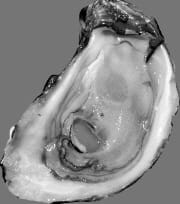The World is Your Oyster

Photo: NOAA
Today, the economic value of the oyster industry at its previous size would be huge, but it isn't only the economy that would benefit in Chesapeake Bay, such an industry has the potential to transform the community completely.
Towns such as Crisfield on Maryland’s Eastern Shore were established and prospered solely on the basis of the abundance of oysters in local waters. So important was the oyster to the Chesapeake Bay region that it became widely recognized as a cultural symbol.
The abundant oyster was a keystone species that provided a variety of ecological services within the Chesapeake Bay ecosystem.
It was a primary component of the Bay’s filtration system and provided rich habitat for many other species (Newell 1988). Oysters filter water to feed on small plankton, removing sediment and other particles from the water column, clearing the water, and increasing light penetration in the process.
Improved water clarity promotes the growth of underwater grasses, which benefit blue crabs and many other aquatic organisms. Oyster reefs also provide a unique kind of habitat for fish and other species in the Bay.
The Downfall of Eastern Oyster
According to a report by the U.S. Army Corps of Engineers, it is said that the Eastern oyster (Crassostrea virginica) was once so abundant in Chesapeake Bay that it inspired the Algonquin to name the bay Chesepiook, meaning "great shellfish bay."
But after one hundred years of overfishing, pollution and destruction of habitat the oyster population was levelled to far more modest numbers. Many other factors contributed to the decline and this continued until the mid-20th century - when oyster harvests remained comparatively stable for several decades - before beginning another steep decline that continues to the present.
This time, two foreign diseases, Dermo and MSX, attacked the Eastern oyster to which it had no resistance. These diseases have been particularly detrimental to the oyster fishery because they kill many oysters before they reach market size.
Given that oyster diseases appear to be a major factor inhibiting recovery, the States began investigating the possibility of introducing a nonnative oyster that is resistant to these diseases.
The Next Step
|
The Eight Scenarios
|
|
| Alternative 1: | No Action |
|---|---|
| Alternative 2: | Enhance Efforts to Restore the Native Oyster |
| Alternative 3: | Harvest Moratorium |
| Alternative 4: | Cultivate Eastern Oysters |
| Alternative 5: | Cultivate Nonnative Oysters |
| Alternative 6: | Introduce Another Nonnative Oyster Species |
| Alternative 7: | Introduce the Suminoe Oyster and Discontinue Efforts to Restore the Eastern Oyster |
| Alternative 8: | Combination of Alternatives |
Beginning in 2004, Maryland, Virginia, the Potomac River Fisheries Commission, and the National Oceanic and Atmospheric Administration funded extensive research on the Suminoe oyster, focusing largely on questions of risk identified in the NRC’s report.
In response the Norfolk District of the U.S. Army Corps of Engineers, the Maryland Department of Natural Resources, and the Virginia Marine Resources Commission prepared a variety of strategies for attempting to restore the population of oysters throughout Chesapeake Bay. The report concluded that:
"A need exists to restore the ecological role of oysters in the Bay and the economic benefits of a commercial fishery through native oyster restoration and/or an ecologically compatible nonnative oyster species that would restore these lost functions.
"The purpose of this proposal is to establish an oyster population that reaches a level of abundance in Chesapeake Bay that would support sustainable harvests comparable to harvest levels during the period 1920–1970."
The report weighed up eight different scenarios before coming to a conclusion.
Introducing... the Suminoe 0yster
After evaluating the probable outcomes of eight scenarios the researchers proposed to introduce a nonnative species, the Suminoe oyster, and continue efforts to restore the native Eastern oyster. The Suminoe oyster is a native of the China Sea that has environmental requirements and tolerances similar to those of the Eastern oyster but is resistant to diseases that have adversely affected the Eastern oyster.
In various studies conducted in the Bay, the Suminoe oyster exhibited greater survival rates and grew faster than the native Eastern oyster.
Those studies suggested that the Suminoe oyster has the potential to improve the oyster fishery and water quality in Chesapeake Bay, which encouraged greater interest in the possibility of introducing the species.
The Proposed Action: Problems and Benefits
They concluded that disease resistance and rapid growth of the Suminoe oyster could contribute to a substantial increase in the Bay-wide oyster population and the potential to attain the restoration goal. However, continuing habitat loss, vulnerability to predation, and competition with the Eastern oyster are some of the factors that could constrain such an increase.
They also believe that the Suminoe oyster will provide ecosystem services similar to those provided by the Eastern oyster. The bay would be on the whole more visually pleasing due to increased activity of recreational fishing for reef-oriented fish and waterfowl hunting for diving ducks.
However the increased activity would lead to a "slight localized decreases in air quality with increased boat operation for introduction programs and increased harvesting activity."
The researchers also highlighted a high probability of dispersal of Suminoe oyster into adjacent coastal waters. Coexistence with Eastern oyster is likely, but ranging potentially from local dominance of one species or the other to mixed species reefs of different proportions.
The estimated present value cost to implement the programme over 10 years is $264 million. The economic benefits should it succeed were not calculated due to uncertainty of figures, but the real value, to both the economy and the community, is sure to be priceless.

